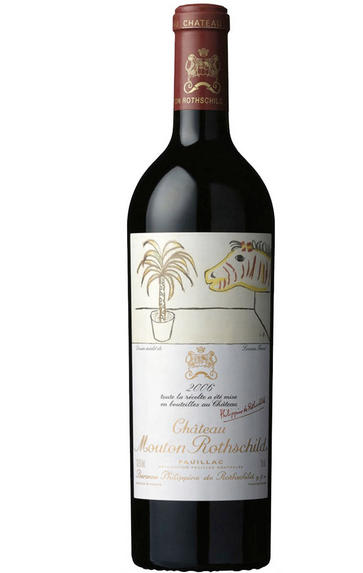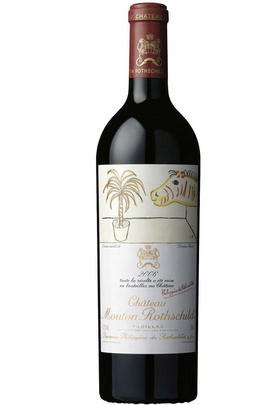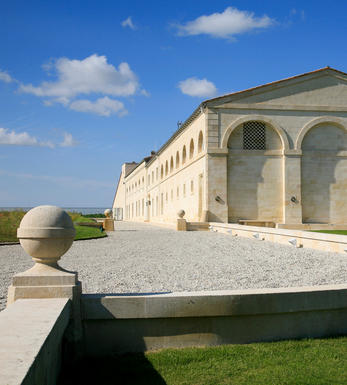
2006 Château Mouton Rothschild, Pauillac, Bordeaux

Critics reviews
The breadth and depth of this wine is impossible to ignore. Tobacco notes blend with cappuccino, cedar and grilled almonds. This is classy, with just the right amount of abandon. Grilled black fruits are very Mouton but with the touch of austerity and pulled-in, pared-down tannins that tell you it’s 2006. Complex and complete.
Drink 2018 - 2040
Jane Anson, Decanter.com
Tasted at the Mouton-Rothschild vertical in London, the 2006 Mouton-Rothschild was really the wine that put winemaker Philippe Dhalluin on the map, in the sense that unlike the 2005 born in a great vintage, this 2006 had to transcend it.
It remains one of the growing season's standouts and replicates previous showings just the week earlier and in January. As expected, the nose has quite a brilliant delineation with blackberry and graphite, here an almost cold slate-like scent. The palate is harmonious with the carefully judged acidity, fine-grain tannin and immense detail on the finish.
Recent bottles suggest that it may close up for several years, in which case, either enjoy this in the next few months or cellar this for a few years and receive vinous dividends down the line.
Drink 2023 - 2055
Neil Martin, Wine Advocate (January 2017)
Lucian Freud label. Dark crimson. Refined, lifted, elegant nose with masses of polish. Sweet palate entry and very confident terroir-determined nose. Dry finish. Very appetising. Racy. Prescient in a way because this is the style of wine people are looking for now. Lead-pencil flavours. Dry tannins in the background. Food please!
This will never be massive, but the balance is great.
Drink 2020 - 2040
Jancis Robinson MW, JancisRobinson.com (March 2016)
This is an eye-opener with a tight core of complex fruit character and subtle chocolate and spices. Full body, firm tannins and a classy finish. Holding back. Much better than expected. A vintage forgotten.
Better in 2018
James Suckling, JamesSuckling.com (March 2015)
A sensational effort, the 2006 Mouton Rothschild exhibits an opaque purple colour and a classic Mouton perfume of creme de cassis, flowers, blueberries, and only a hint of oak. Dalhuin told me that in whisky barrel-tasting vintages such as 1989 and 1990, Mouton was aged in heavily toasted barrels, and they have backed off to a much lighter toast for the barrels’ interior. This has worked fabulously with the cassis quality fruit they get from Cabernet Sauvignon.
The full-bodied, powerful 2006 possesses extraordinary purity and clarity. A large-scaled, massive Mouton Rothschild that ranks as one of the top four or five wines of the vintage may turn out to be the longest-lived wine of the vintage by a landslide. The label will undoubtedly be controversial as a relative of Sigmund Freud, Lucian Freud, has painted a rather comical Zebra staring aimlessly at what appears to be a palm tree in the middle of a stark courtyard.
I suppose a psychiatrist could figure out the relationship between that artwork and wine, but I couldn’t see one. This utterly profound Mouton will need to sleep for 15+ years before revealing any secondary nuances, but it is a packed and stacked first-growth Pauillac of enormous potential.
Anticipated maturity: 2020 - 2060+
Robert M. Parker, Jr., Wine Advocate (February 2009)
The best first growth of the year? I have always believed so, right out of the Primeurs. Ruby, but with a garnet rim (much less impenetrable colour-wise than the 2005), with brightly floral strawberry and red cherry nuances along with savoury underbrush and a hint of cèpes. Very suave, long and polished.
Drink 2016 - 2045
Ian D'Agata, Decanter.com
Bright ruby-red. Vibrant aromas of cassis, blueberry, cedar and graphite. Wonderfully pure and silky in the mouth, with great subtle, slow-building intensity and superb energy and thrust. A real essence of cabernet sauvignon and Mouton terroir This one really rattled my brain in the gentlest way. As silky as it is, it possesses bottomless depths. Finishes with big but noble tannins and outstanding length.
I loved this wine the spring after the harvest, and it's even more impressive today. This should go on for decades, but today, it's hard to imagine this wine going through an extended sullen stage. By the way, I'm a great fan of Lucien Freud's work, but his label for this wine does not do justice to the juice inside the bottle.
Stephen Tanzer, Vinous.com (May 2009)
About this WINE

Château Mouton Rothschild
Classified as a First Growth, Château Mouton Rothschild has a long and storied history; wine has been made here since Roman times. The property spans 82 hectares of vines in Pauillac, planted with the classic varieties of the region, Cabernet Sauvignon being predominant.
The estate has been in the Baron Philippe de Rothschild family since 1853, but it wasn’t until the arrival of Baron Philippe de Rothschild in 1922 that its fortunes were transformed. Baron Philippe was a dynamic figure who revolutionised the estate and was the first to introduce château-bottling in 1924. He also introduced the concept of commissioning an artist to design each new vintage’s label. Some of the most notable contributors include Salvador Dalí, Henry Moore, Marc Chagall, Francis Bacon, Lucian Freud, Anish Kapoor and Peter Doig.
His daughter Baroness Philippine continued to help raise the estate to new heights with numerous endeavours, including the inauguration of a new vat house in 2013. Today, her three children, Camille and Philippe Sereys de Rothschild and Julien de Beaumarchais de Rothschild, continue the efforts of their predecessors.
Following the retirement in 2020 of Philippe Dhalluin, the winemaking team is now headed up by Jean-Emmanuel Danjoy. With his team, he oversees over 83 hectares of vines, planted with Cabernet Sauvignon (78%), Merlot (18%), Cabernet Franc (3%), and Petit Verdot (1%). The average age of the vines is around 50 years.

Pauillac
Pauillac is the aristocrat of the Médoc boasting boasting 75 percent of the region’s First Growths and with Grand Cru Classés representing 84 percent of Pauillac's production.
For a small town, surrounded by so many familiar and regal names, Pauillac imparts a slightly seedy impression. There are no grand hotels or restaurants – with the honourable exception of the establishments owned by Jean-Michel Cazes – rather a small port and yacht harbour, and a dominant petrochemical plant.
Yet outside the town, , there is arguably the greatest concentration of fabulous vineyards throughout all Bordeaux, including three of the five First Growths. Bordering St Estèphe to the north and St Julien to the south, Pauillac has fine, deep gravel soils with important iron and marl deposits, and a subtle, softly-rolling landscape, cut by a series of small streams running into the Gironde. The vineyards are located on two gravel-rich plateaux, one to the northwest of the town of Pauillac and the other to the south, with the vines reaching a greater depth than anywhere else in the Médoc.
Pauillac's first growths each have their own unique characteristics; Lafite Rothschild, tucked in the northern part of Pauillac on the St Estèphe border, produces Pauillac's most aromatically complex and subtly-flavoured wine. Mouton Rothschild's vineyards lie on a well-drained gravel ridge and - with its high percentage of Cabernet Sauvignon - can produce (in its best years) Pauillac's most decadently rich, fleshy and exotic wine.
Latour, arguably Bordeaux's most consistent First Growth, is located in southern Pauillac next to St Julien. Its soil is gravel-rich with superb drainage, and Latour's vines penetrate as far as five metres into the soil. It produces perhaps the most long-lived wines of the Médoc.
Recommended Châteaux
Ch. Lafite-Rothschild, Ch. Latour, Ch. Mouton-Rothschild, Ch. Pichon-Longueville Baron, Ch. Pichon Longueville Comtesse de Lalande, Ch. Lynch-Bages, Ch. Grand-Puy-Lacoste, Ch, Pontet-Canet, Les Forts de Latour, Ch. Haut-Batailley, Ch. Batailley, Ch. Haut-Bages Libéral.

Cabernet Sauvignon Blend
Cabernet Sauvignon lends itself particularly well in blends with Merlot. This is actually the archetypal Bordeaux blend, though in different proportions in the sub-regions and sometimes topped up with Cabernet Franc, Malbec, and Petit Verdot.
In the Médoc and Graves the percentage of Cabernet Sauvignon in the blend can range from 95% (Mouton-Rothschild) to as low as 40%. It is particularly suited to the dry, warm, free- draining, gravel-rich soils and is responsible for the redolent cassis characteristics as well as the depth of colour, tannic structure and pronounced acidity of Médoc wines. However 100% Cabernet Sauvignon wines can be slightly hollow-tasting in the middle palate and Merlot with its generous, fleshy fruit flavours acts as a perfect foil by filling in this cavity.
In St-Emilion and Pomerol, the blends are Merlot dominated as Cabernet Sauvignon can struggle to ripen there - when it is included, it adds structure and body to the wine. Sassicaia is the most famous Bordeaux blend in Italy and has spawned many imitations, whereby the blend is now firmly established in the New World and particularly in California and Australia.


Buying options
Add to wishlist
Description
87% Cabernet Sauvignon and 13% Merlot.
Tasted at the Mouton-Rothschild vertical in London, the 2006 Mouton-Rothschild was really the wine that put winemaker Philippe Dhalluin on the map, in the sense that unlike the 2005 born in a great vintage, this 2006 had to transcend it. It remains one of the growing season's standouts and replicates previous showings just the week earlier and in January.
As expected, the nose has quite a brilliant delineation with blackberry and graphite, here an almost cold slate-like scent. The palate is harmonious with the carefully judged acidity, fine-grain tannin and immense detail on the finish. Recent bottles suggest that it may close up for several years, in which case, either enjoy this in the next few months or cellar this for a few years and receive vinous dividends down the line.
Drink 2023 - 2055
Neil Martin, Wine Advocate (January 2017)
wine at a glance
Delivery and quality guarantee